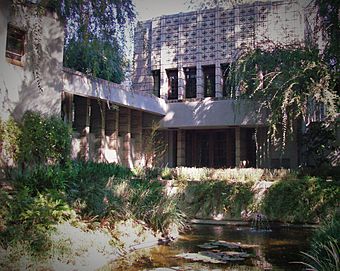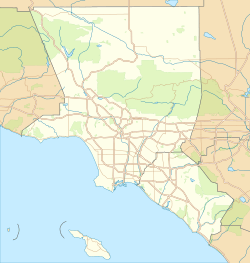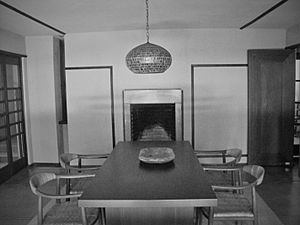Millard House facts for kids
Quick facts for kids |
|
|
Millard House
|
|
 |
|
| Location | 645 Prospect Crescent, Pasadena, California |
|---|---|
| Built | 1923 |
| Architect | Frank Lloyd Wright; Lloyd Wright |
| Architectural style | Organic architecture |
| NRHP reference No. | 76000493 |
| Added to NRHP | December 12, 1976 |
The Millard House, also called La Miniatura, is a special house in Pasadena, California. Famous architect Frank Lloyd Wright designed it in 1923. It's known for its unique 'textile block' style. In 1976, it was added to the National Register of Historic Places, which means it's an important historical building.
Frank Lloyd Wright's Special Building Blocks
The Millard House was the first of four "textile block" homes built by Frank Lloyd Wright. All four were constructed in Los Angeles County between 1923 and 1924. Wright started this project after finishing the Hollyhock House in Hollywood and the Imperial Hotel in Japan.
At this time, Wright felt known only for his "Prairie style" houses. He wanted to try new things in architecture. So, he decided to build with concrete blocks. Wright wrote that he chose concrete blocks because they were "the cheapest (and ugliest) thing in the building world." He wanted to show what amazing things could be done with them.
These homes were called "textile-block" houses because their concrete walls looked like rich, woven fabric. Wright was experimenting with a new way to build homes. He hoped to create a simple and cheap method. This would allow regular people to build their own homes by stacking blocks. By adding cool designs to these blocks, Wright believed they could become a beautiful "masonry fabric." This means the blocks would act like a strong, decorative cloth.
Designing the Millard House: Blending with Nature
Alice Millard, a rare-book dealer, asked Wright to build the Millard House. Wright had built a home for her before, in Highland Park, Illinois, in 1906.
Wright wanted the Millard House to fit perfectly with the land. He designed it to hug the side of a steep ravine. He also placed it among the trees. The concrete blocks for the house were made using sand, gravel, and minerals found right on the property. By using rough, earthy-colored blocks, he wanted the house to blend with the trees and hillside.
This design was different from Wright's earlier work in many ways. But it still showed his love for natural materials. He always believed that buildings should look like they belong in their surroundings. He later said that Millard House "belonged to the ground on which it stood."
The concrete blocks were made in wooden molds. They had patterns on the outside and were smooth on the inside. Each block has a pattern of a cross with a square in each corner. Wright used regular mortar to hold the blocks together. The house cost $17,000 to build. This was more than the $10,000 budget Alice Millard had given Wright.
The house is about 2,400 square feet and has three stories.
- The first floor has the kitchen, a servant's room, and a dining room. The dining room opens onto a terrace with a reflecting pool.
- The second floor has the main entrance, a guest room, and a two-story living room. This living room has a fireplace and a balcony.
- The third floor held Millard's bedroom. It has a balcony that looks over the living room and the outdoor terrace.
Like many of Wright's homes, the Millard House sometimes had leaks when it rained. After a storm caused flooding, Alice Millard wrote to Wright. She complained that the storm drain wasn't good enough. This caused the basement to fill with muddy water. Water also rose to six inches in the dining room.
In 1926, Millard added a separate studio. This studio was designed by Wright's son, Lloyd Wright.






